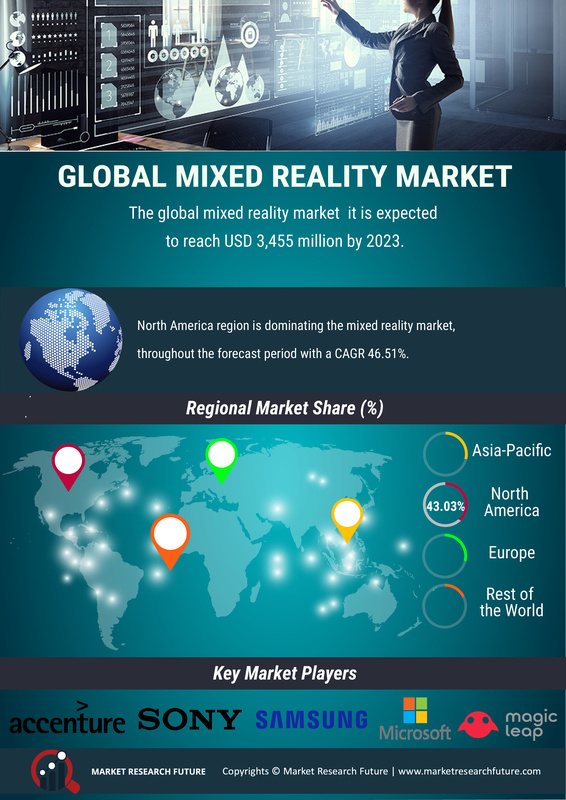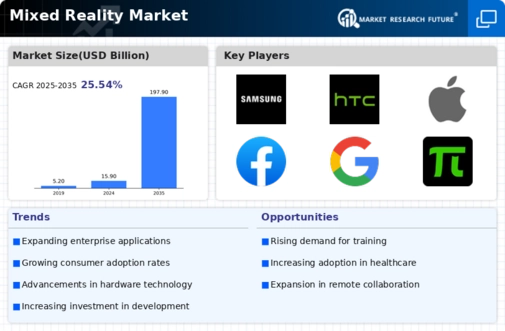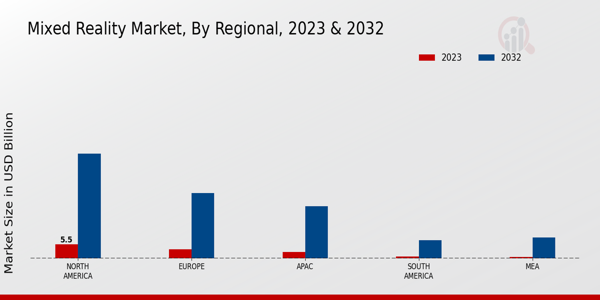Market Growth Projections
The Global Mixed Reality Market Industry is projected to experience substantial growth, with estimates indicating a market size of 15.9 USD Billion in 2024 and a remarkable increase to 197.9 USD Billion by 2035. This trajectory suggests a compound annual growth rate of 25.79% from 2025 to 2035, highlighting the increasing adoption of mixed reality technologies across various sectors. The anticipated growth is driven by factors such as technological advancements, expanding applications in education and healthcare, and rising investments. These projections underscore the transformative potential of mixed reality in reshaping industries and enhancing user experiences.
Technological Advancements
The Global Mixed Reality Market Industry is experiencing rapid growth due to continuous technological advancements. Innovations in hardware, such as improved headsets and sensors, enhance user experiences and broaden applications across various sectors. For instance, companies are integrating artificial intelligence and machine learning to create more immersive environments. This evolution not only attracts investment but also encourages the development of new applications in education, healthcare, and entertainment. As a result, the market is projected to reach 15.9 USD Billion in 2024, indicating a robust trajectory fueled by these advancements.
Rising Investment and Funding
The Global Mixed Reality Market Industry is benefiting from rising investment and funding from both public and private sectors. Governments are recognizing the potential of mixed reality technologies to drive economic growth and innovation, leading to increased funding for research and development initiatives. Additionally, venture capital firms are investing in startups focused on mixed reality applications, further fueling market expansion. This influx of capital is likely to accelerate the development of new products and services, enhancing the overall market landscape. As investment continues to rise, the market is expected to flourish, reflecting the growing interest in mixed reality solutions.
Increased Adoption in Education
The Global Mixed Reality Market Industry is witnessing increased adoption in the education sector, where immersive learning experiences are becoming more prevalent. Institutions are leveraging mixed reality to create interactive simulations that enhance student engagement and understanding of complex subjects. For example, medical schools utilize mixed reality for surgical training, allowing students to practice in a risk-free environment. This trend is likely to contribute significantly to the market's growth, as educational institutions recognize the value of these technologies in improving learning outcomes. The anticipated growth in this sector aligns with the overall market expansion, projected to reach 197.9 USD Billion by 2035.
Expansion in Healthcare Applications
The Global Mixed Reality Market Industry is experiencing notable expansion in healthcare applications, where mixed reality technologies are revolutionizing patient care and medical training. Surgeons are employing mixed reality for pre-operative planning and intra-operative guidance, improving surgical precision and outcomes. Additionally, mixed reality is being utilized for patient rehabilitation, offering engaging exercises that enhance recovery. This growing integration of mixed reality in healthcare is indicative of its potential to transform traditional practices, thereby driving market growth. As healthcare providers increasingly adopt these technologies, the market is poised for significant expansion in the coming years.
Growing Demand for Remote Collaboration
The Global Mixed Reality Market Industry is increasingly driven by the growing demand for remote collaboration tools. As organizations embrace hybrid work models, mixed reality solutions facilitate seamless communication and collaboration among distributed teams. For instance, companies are utilizing mixed reality platforms to conduct virtual meetings and collaborative design sessions, enhancing productivity and creativity. This shift towards remote collaboration is expected to propel market growth, as businesses seek innovative solutions to overcome geographical barriers. The market's compound annual growth rate of 25.79% from 2025 to 2035 reflects the potential of mixed reality in transforming workplace dynamics.

















